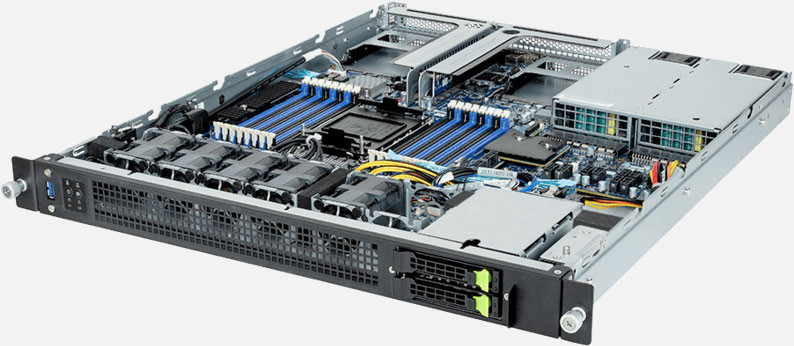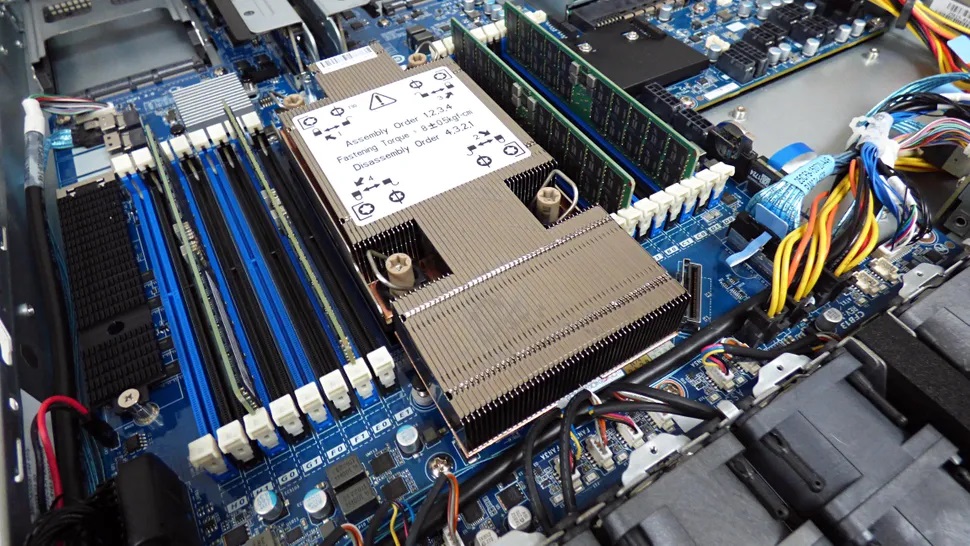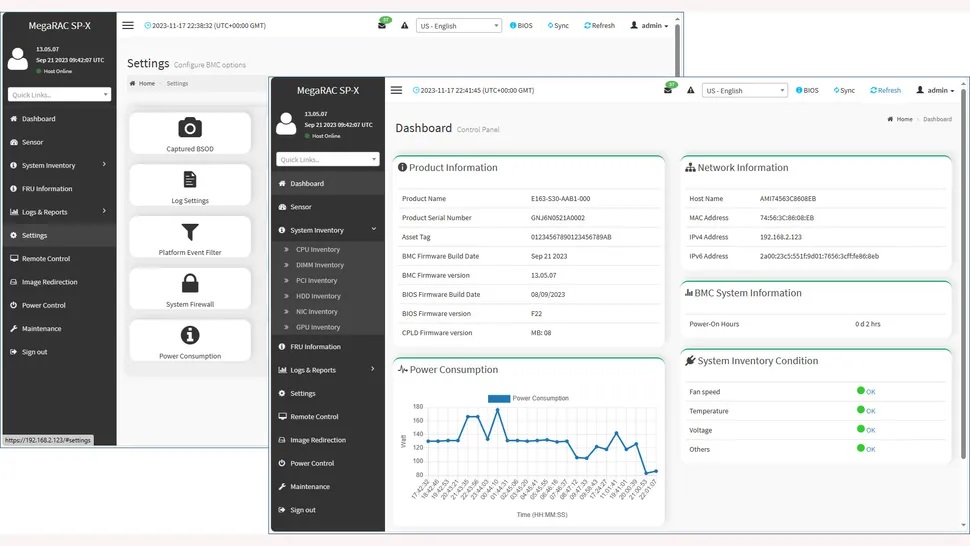 Alle Bestellungen werden in Deutschland gefertigt, versandt und unterstützt
Alle Bestellungen werden in Deutschland gefertigt, versandt und unterstützt

 Alle Bestellungen werden in Deutschland gefertigt, versandt und unterstützt
Alle Bestellungen werden in Deutschland gefertigt, versandt und unterstützt

A small, powerful, and affordable rack server. Broadberry gets edgy with a great value rack server that'll fit in small spaces
Dave Mitchell December 01, 2023 |
Configure From €3,268.67 or Configure


Businesses usually expect to pay a premium for edge servers but Broadberry's CyberServe Xeon SP1-102 NVMe G4 bucks the trend as it offers a compact solution with an equally small price tag. A chassis depth of only 520mm also makes this 1U rack server well-suited to remote or branch office deployments.
Don't be deceived by its modest dimensions as the CyberServe is capable of delivering a very powerful package. It supports Gen4 Xeon Scalable CPUs, has a mighty memory capacity, and offers a surprisingly good expansion potential.
Showcasing Gigabyte's E163-S30 rack server platform, it's thermally rated to handle CPUs up to a 350W TDP so you can choose just about any model you want. Broadberry opted to keep costs under control by dropping a basic 8-core 1.8GHz Bronze 3408U CPU in our review system but you can go right up to a 60-core Platinum.
The server's chassis is of solid construction and under the lid you'll find a well-designed interior with cable-related clutter kept to a minimum. At the heart of the CyberServe is Gigabyte's MS33-DC0 motherboard which presents its single CPU socket towards the front with the Bronze module mounted by an impressively large passive heatsink.
The socket is flanked on each side by a total of 16 DIMM slots allowing the CyberServe to support up to 4TB of fast 4,800MHz DDR5 memory using 256GB 3DS RDIMM modules. The server supports standard RDIMM modules for a maximum of 1.5TB and value looks even better as the price includes a healthy 256GB made up of four 64GB modules.

The server only offers a single Gigabit network port but there's loads of room to expand. Two risers at the rear each provide PCIe Gen5 x16 slots and both have room for full-height, half-length (FHHL) adapter cards.
There's more as the motherboard has OCP (Open Compute Project) 3 bays on each side of the riser assembly and industry-standard mezzanine cards can be installed from the rear without needing to open the server's lid. As with the standard PCIe slots, these are the faster Gen5 x16 variety and Broadberry offers a big choice of Intel and Broadcom mezzanine cards ranging from quad-Gigabit and 10GbE right up to dual-port 100GbE.
Storage features are basic as the server only has room at the front for two SFF hot-plug drive bays. This isn't an issue if you're using the server to provide edge or general networking services and the bays support SATA and NVMe SSD storage devices out of the box.
Our system includes a pair of 2TB Micron 7450 Pro U.3 NVMe SSDs and cabling is kept to a minimum as the motherboard's MCIO (Mini Cool Edge IO) PCIe Gen5 connectors are located right next to the drive cage. Another smart motherboard feature is it comes with Intel's embedded VROC (virtual RAID on CPU) controller and Broadberry includes the standard hardware activation key.
Obviously, with only two drive bays you're limited to striped or mirrored RAID arrays but the VROC controller supports these for both SATA and NVMe devices. This is one area where Xeon Scalable servers score over AMD as most EPYC-equipped servers don't have embedded SATA/NVMe controllers or integral RAID capabilities.

The motherboard also has a single M.2 NVMe SSD slot that supports 2280 and 22110 cards. This'll come in handy for running a hypervisor and unlike the blue chips, Broadberry allows you to install your own choice of storage devices without invalidating the warranty.
If you're planning on accessing the server locally, bear in mind it has a mini-DP port. This shouldn't be a problem if you don't have a suitable monitor as you can pick up an HDMI or VGA adapter from Amazon for less than a tenner.
For remote management, you have the server's embedded AST2600 IPMI controller and dedicated Gigabit port. Gigabyte has redesigned its web interface and replaced the dashboard's gaudy color blocks with a more informative set of tables showing system and component status along with a graph for power consumption.
You can drill down deeper and pull up detailed graphs of all sensor readings and use the controller's PEF (platform alert filter) services to create policies that issue emails or SNMP traps if any exceed their thresholds and carry out actions such as resetting or powering down the server. The server's bank of five dual-rotor cooling fans are a tad noisy but custom fan profiles can be linked to sensors to control their speed and unlike Dell and HPE, you get full OS remote control and virtual media services as standard and not as a chargeable license upgrade.
Multiple Gigabyte servers can be managed and monitored using the free Gigabyte Server Management (GSM) utility. We ran it in the lab on a Windows Server 2019 host and after its network discovery service located the server's IPMI controller, it loaded a basic dashboard showing the status and overall power consumption of all monitored systems.
Selecting one pulls up a hardware inventory and moving to the monitoring section reveals graphs of temperatures, fan speeds, and voltages for up to a year. A separate section shows power consumption graphs and the console provides tools for remote power controls and firmware upgrades.
There is some blue-chip competition at the network edge but in most cases, their solutions are more specialized. Dell's ruggedized PowerEdge XR11 for example, is aimed at harsher environments such as military use, only supports Gen3 Xeon Scalable CPUs, and is a lot more expensive.
With the system on review costing £3,920, the CyberServe Xeon SP1-102 NVMe G4 delivers an affordable, low-profile rack server solution. It offers plenty of PCIe Gen5 expansion options, supports all the latest Gen4 Xeon Scalable CPUs, and clearly has the power to run a wide choice of applications.
| System | 1U Gigabyte E163-S30 |
| Motherboard | Gigabyte MS33-DC0 |
| CPU | 8-core 1.8GHz Intel Xeon Scalable Bronze 3408U |
| Memory | 256GB 4,800MT/s DDR5 ECC (max 4TB) |
| Storage bays | 2 x SFF NVMe/SAS/SATA hot-swap drive bays |
| Other storage | 1 x M.2 NVMe SSD slot |
| RAID | Intel VROC for SATA/NVMe |
| Storage included | 2 x 2TB Micron 7450 Pro U.3 NVMe SSDs |
| Network | 1 x Gigabit |
| Expansion | 2 x PCIe Gen5 x16 slots, 2 x OCP 3 Gen5 mezzanine slots |
| Power | 2 x 800W 80 Plus Platinum hot-plug PSUs |
| Management | Aspeed AST2600 RMC with Gigabit, Gigabyte Server Manager |
| Warranty | 3yrs advanced replacement |